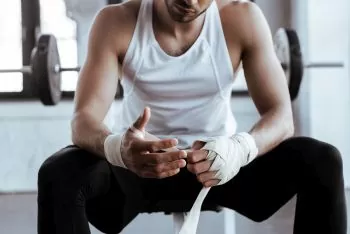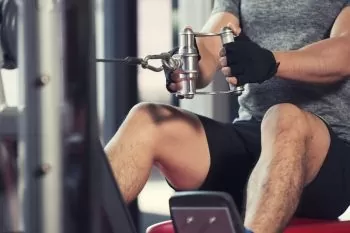
We kind of have a love/hate relationship with our bodies and our exercise machines, don’t we?
I mean, we love what they do for our bodies and the way our rowing machines can make us stronger and healthier, helping us maintain our weight. However, when an injury happens or we start feeling pain, we come to hate that rowing machine and blame it for all our woes!
Well, at least I do sometimes!
Beginners and even the more advanced rowers can experience rowing injuries ranging from back pain to elbow pain and wrist pain.
In today’s article, I want to talk about what you can do if you find that you’ve injured your wrist and how to avoid doing so in the future.
Inflammation and wrist injuries may not be the hot topic of the summer, but if this is your current story, it certainly matters to you!
Why Do My Hands and Wrists Hurt After Rowing?
Like the knees and elbows, our wrists have tendons connecting the muscles to the bones.
Tendons are notorious drama queens in that they can get all bent out of shape from simple things like overuse or poor technique.

Even when you do everything right, you can still have pain in the wrists or experience rowing injuries like tendonitis because, you know, tendons are like that.
Doctors call your tendonitis wrist extensor tenosynovitis. Whether it comes from poor technique while rowing, typing too much on your computer, overuse, or a combination of these causes, wrist pain can occur for any number of reasons.
Basically, your tendons experience inflammation and need to rest. Rowers aren’t known for quitting training, so what can you do?
Let’s talk about rowing wrist injuries and what you can do about it.
Want the Very Best Machine? Click Here!
Rowing Wrist Tendonitis
Like tennis elbow (tendonitis in the elbow) the only real “cure” for tendonitis is to ice the area and allow it to rest for a few weeks.
No one I know wants to do this; however, that is sometimes necessary.

Unfortunately, you may find that even if you do everything the doctor orders, your wrist tendonitis will return within a few days or weeks after you return to training.
Unlike our muscles, tendons do not have a blood supply, so there is virtually no way you can heal the affected tendon through massages or other blood circulation methods.
What Causes Wrist Injuries while Rowing?
In all honesty, overuse is one of the main culprits.
However, there are other factors that may also come into play including:
- Holding the handle too tightly
- A handle that is too large
- Incorrect hand/arm position on the Finish phase of your strokes
- Poor technique
- Cold weather
Of course, cold weather is perhaps the least of your problems since this is easy to solve. Wear long sleeves or wrist warmers that will keep your forearm and wrist warm if your indoor rower is in a room where it is very cold.

If the handle on your device is too large for you, you may need to make some modifications. I recommend that you contact the manufacturer and see if there is another type or size of handle that you can buy, or whether they can help you with a modification that won’t affect the rowing machine.
Don’t keep a death grip on the handle. There is no need for anything more than minimal pressure except during the Finish. Even then, try to use your arms to pull, and don’t squeeze the handle very hard with your hands. Imagine holding a kitten, not a snake!
So items 3 and 4 are almost the same, but not quite. First, you want to have your hands in the correct position. Don’t put your hands close together on the handle but rather on the outside edges of the handle. It may feel less stable for beginners, but as you get stronger, you will feel less wobble in the handle.
You also need proper technique. More injuries occur when rowing, including injuries to the elbows, lower back, and wrists, due to poor rowing technique.
On the Finish phase, do not stick your elbows out to the sides like a bird. Keep your elbows close to your rib cage and pull towards your chest. You don’t have to hit your chest with the handle, just pull it near the chest.
Pay attention to your wrist position on the Finish. Your wrist should be in line with your forearm for the most part and not bent at a weird angle.
- Interested in a Water Rower – Click Here to See the Ergatta Rowing Machine Price!
Rowing Injuries Happen
Even professional athletes with years of rowing or training can experience pain or a wrist injury.
If you feel pain in your wrist, put ice on the area and see your doctor immediately. If your doctor tells you that your wrist needs rest, then do as the doctor orders.

You can do other exercises, such as walking, jumping on a trampoline, swimming, or working out on other exercise machines that don’t involve your hands.
If wrist pain returns, you may want to try rowing using a special wrist splint that they make for carpal tunnel syndrome.
Stretching the forearms, wrists, and upper body will help prevent wrist injuries and pain.
The Bottom Line
No one likes to be sidelined with an injury, but it happens.

Take care of your body and give yourself the rest you deserve if ever you get injured.
Be sure that you are using the proper form and technique when rowing and wear wrist splints if you need to.
More than anything else, take care of yourself and have a good time! Isn’t that what rowing is all about?
Written by Petra Amara – RowingCrazy.com
CEO & Founder of RowingCrazy, National Rower, Coxswain Womens Eight Team, Rowing Coach & Writer
Petra is a Mother of two and owner of Rowingcrazy.com. Petra lives and breathes rowing, she also has a passion for writing which lead her to start RowingCrazy.com to share her rowing experience and expertise with others.







Pingback: Get Killer Abs with the Correct Rowing Machine Form!Rowing Crazy
Pingback: What Should Be Sore After Rowing? Rowing Crazy
Pingback: Water Rowing Machine Benefits & Drawbacks - Rowing Crazy
Pingback: Can Rowing Cause IT Band Pain? Find Out Here! Rowing Crazy